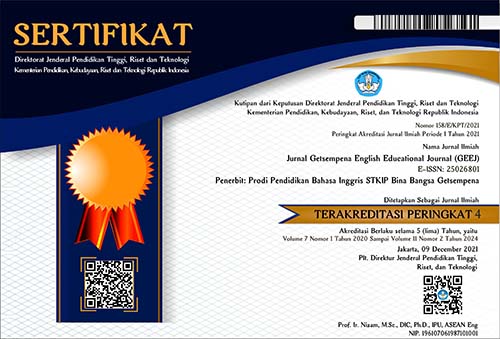ENGLISH LEARNING MODEL: AN ETHNOGRAPHY STUDY
Abstract
The learning model is included in the civilization process of the School. It is as a culture aiming at academic achievement, cultivates attitudes, knowledge and skills of students. The habituation learning model of the pesantren style (Islamic Boarding school) applied by MAS (Islamic Senior High School) Jeumala Amal has successfully increase the school's achievements. Based on the aforementioned data, the researcher needs to do more in-depth research in obtaining detailed information reagarding the model applied so that it is applicable for other schools. This study aims to gain a deeper understanding of the English learning model at MAS Jeumala Amal which applies a qualitative ethnographic method. The data obtained were observation, interviews, field notes and document analysis. The Study revealed that the form of English language learning is designed through a careful planning which integrates two proficiencies, namely functional and communication skills; the former are taught through classroom activities while the latter are trained more in pesantren programs. The student learning models in MAS Jeumala Amal adheres to a behavioristic pattern which emphasizes habituation in language skills through an army method pattern that restrain students based on reward and punishment pattern.
References
Amal, D. J. (2017). Prestasi MA Jeumala Amal. Retrieve from http://jeumalaamal.org/2017/09/prestasi-ma-jeumala-amal-tahun-2017/.
Arends, R. (1997). Classroom instruction and management. McGraw-Hill Companies.
Bin-Tahir, S. Z., Atmowardoyo, H., Dollah, S., & Rinantanti, Y. (2017). Multilingual Instructional Model of Pesantren Schools in Indonesia. Journal of Language Teaching and Research, 8(6), 1210. https://doi.org/10.17507/jltr.0806.24
Bogdan, R., & Biklen, S. K. (1997). Qualitative research for education. Boston,MA: Allyn & Bacon.
Boyle, O., & Peregoy, S. (1993). Reading, writing, and learning in ESL.
Brown, H. Douglas. (2001).Teaching by principle (an interactive approach to language pedagogy). San francisco State University,
---------------., (2000). Principle of Language Learning and Teaching. Fourth Edition, San Francisco State University
Calderon-Young, E. (1999). Technology for teaching foreign languages among community college students, 23, 161–169.
Cresswell, J. W. (2008). Educational research: Planning, conducting, and evaluating quantitative and qualitative research. New York, NY: Prentince Hall .
Davis, S., Crumpler, T. P., Stallworth, C., Kathleen, M., Lenski, S. D., Crumpler, T. P., Crawford, K. M. (2017). Linked references are available on JSTOR for this article : Beyond Awareness : Preparing Culturally Responsive, 32(2), 85–100.
Diaab, S. (2016). Role of Faulty Instructional Methods in Libyan EFL Learners Speaking Difficulties. Procedia-Social and Behavioral Sciences , 232 , 338-345.
Ding, A. C. E., Ottenbreit- Leftwich, A., Lu, Y. H., & Glazewski, K. (2019). EFL Teachers’ Pedagogical Beliefs and Practices With Regard to Using Technology. Journal of Digital Learning in Teacher Education , 1-20., 1–20.
Falzon, M. (2009). Multi-Sited Ethnography: Theory. Praxis and Locality.
Golonka, E. M., Bowles, A. R., Frank, V. M., Richardson, D. L., & Freynik, S. (2014). Technologies for foreign language learning: a, 27.
Hersh, R. (1980). Models of Moral Education: An Appraisal.
Jiang, Y., & Dewaele, J. M. (2019). How unique is the foreign language classroom enjoyment and anxiety of Chinese EFL learners?. System .
Joyce, B., Weil, M., & Calhoun, E. (2009). Models of Teaching (Eight Edition). Upper Saddle River, New Jersey, USA.
Joyce, B. (2003). MODELS OF TEACHING FIFTH EDITION (FIFTH). New Delhi.
Kaya, Z., & Akdemir, A. S. (2016). Learning and teaching: Theories approaches and models. Ankara: Çözüm Eğitim Yayıncılık .
Kern, Richard. (2000).Literacy and Language Teaching, oxford: University press.
Kilbane, Clare R., and N. B. M. (2014). Kilbane, Clare R., and Natalie B. Milman. (2014). Teaching models: Designing instruction for 21st century learners . Pearson, (p. 19-20), 2014.
Larsen-freeman, D. (2000). Techniques and Principles in Language Teaching.
Lauder, A. (2008). The Status and Function in Indonesia: A Review of Key Factor. Makara, Social Humanities, 12 (1), 9-20.
Manurung, K. (2015). Improving the Speaking Skill Using Reading Contextual Internet-based Instructional Materials in an EFL Class in Indonesia., 176, 2015.
Mattarima, K., Hamdan, A. (2011). The Teaching Concept of English as a Foreign Language in Indonesia, 4.
Mercer, N. (2007). Sociocultural discourse analysis: analyzing classroom talk as a social mode of thinking. Journal of Applied Linguistics, 1(2), 137–168. https://doi.org/10.1558/japl.v1i2.137
Nation, I.S.P & John Macalister, (2010). Language Curriculum Design, New York: Routledge
Silseth, K., & Erstad, O. (2018). Connecting to the outside: Cultural resources teachers use when contextualizing instruction. Learning, Culture and Social Interaction, 17(22), 56–68. https://doi.org/10.1016/j.lcsi.2017.12.002
Schein, Edgar H, (2004). Organizational Culture and Leadership, Published by Josses-Bass A Willey imprint San Franscisco.
Stracke, E. (2016). Language learning strategies of Indonesian primary school students: In relation to self-efficacy beliefs. System , 60 , 1-10., 2016.
Strauch, C. C., Jamal, M., & Omar, A. (2014). Critical Analysis of Learning Theories and Ideologies and Their Impact on Learning: “Review Article.” The Online Journal of Counselling and Education, 3(2), 62–77.
Waddington, J. (2019). Developing primary school students’ foreign language learner self- concept.
Williams, J. L. (2011). A difference in ELL instruction: A study of 50/50 dual-immersion bilingual literacy program for second grade English language learners (Doctoral dissertation, Capella University).
























